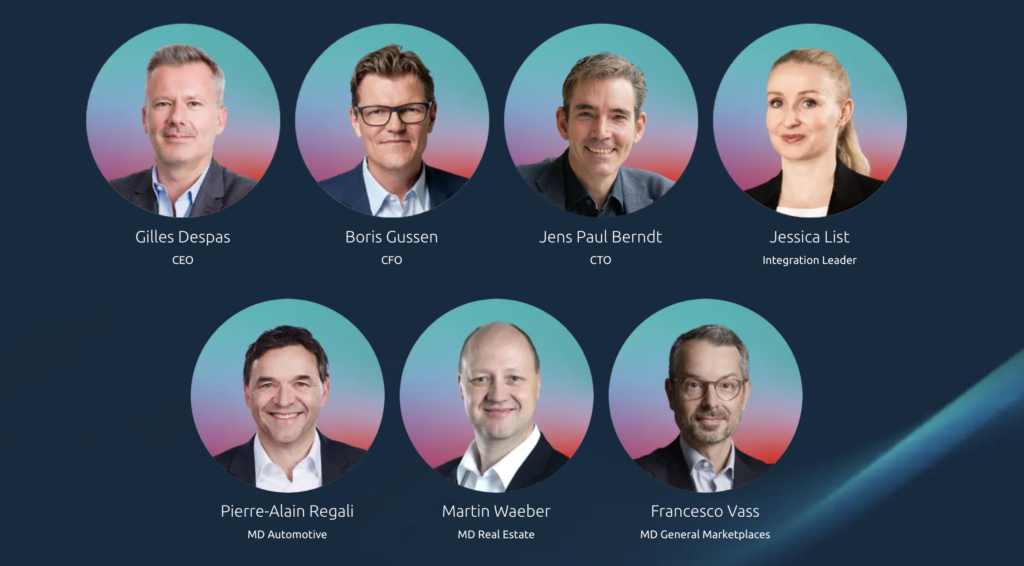Digital, innovative products are born where people use solutions, experience challenges, and express expectations. At SMG Swiss Marketplace Group, product development begins with a thorough analysis: What concerns our users? What recurring questions and problems do they face? And how can these insights be transformed into digital services that provide real added value? Using the examples of Ricardo’s MoneyGuard and the EV Hub from AutoScout24, we demonstrate how new products are developed at SMG and why our users are at the centre of every innovation.
Even though reality is far more complex, our product development follows a clear process: it begins with careful analysis, continues through cross-functional collaboration – and doesn’t stop after launch. That’s because digital, innovative products and services evolve continuously.
Every Idea Begins with Listening, Analysing, Conceptualising
The first phase of product innovation lays the foundation: a systematic analysis of user needs and data. This involves surveys, evaluation of customer service feedback, market and competitor analyses, benchmarking, and data-driven insights.
🔒 Ricardo – MoneyGuard
Many Ricardo users expressed a desire for greater security when buying and selling – for example, protection against non-delivery after prepayment or when items don’t match their descriptions. At the same time, the number of fraud attempts in Swiss online commerce was rising worryingly. For many, such uncertainties in private online transactions are a reason to opt for new products from traditional shops rather than choosing sustainable second-hand alternatives.
“The combination of insights from customer service, our regular user interviews, and the general increase in cyber fraud cases ultimately led to the idea of MoneyGuard,” explains Muzaffer Dogru, Director of Product & Engineering at Ricardo. The idea of a money-back guarantee, as now offered via MoneyGuard, had already been considered for some time. “It became clear to us: the time was right to develop our own model.”
⚡ AutoScout24 – EV-Hub
E-mobility is booming, but potential buyers have many questions: How far can I drive with a certain model? What does charging cost? How does cold weather affect battery life? Even existing drivers seek guidance – for example, about charging stations or cantonal tax regulations.
“We had been observing growing interest in e-mobility for some time, but there was no comprehensive, neutral source of information that also offered practical tools – a proper hub,” says Reem Kadhum, Senior Project Manager Content Marketing at AutoScout24 and product lead for the EV Hub. The foundation came from SEO analyses, user interactions on the AutoScout24 online magazine, topic-specific search trends, and direct customer service feedback. An internal strategic focus was also placed on increasing the use of artificial intelligence – this vision also fed into the idea for the EV Hub.
Teamwork, Testing, Refinement: The Path to Implementation
After the analysis comes the concept and development phase. Teams from various departments develop initial solution approaches, assess technical feasibility, and implement prioritised features step by step – accompanied by feedback loops, data analysis, user surveys, and technical improvements.
🔒 Ricardo – MoneyGuard
MoneyGuard is backed by a team of over 20 experts. Muzaffer highlights the wide range of expertise, “from research to design, engineering and marketing to customer service.” Inspired by familiar Paylivery models, the team developed a tailor-made solution for Ricardo. “We wanted maximum security, but without making the product complicated for users. That was a big ask.”
The first version was launched on a trial basis and offered free to all buyers to gather as much feedback as possible. Based on this feedback, ongoing improvements followed, including additional shipping options and better navigation. “Continuous evaluations allowed us to make quick adjustments. Of course, changes in a live system are always a challenge. Many users are initially cautious about new features,” Muzaffer explains.
⚡ AutoScout24 – EV-Hub
The EV Hub is a dedicated section within the AutoScout24 online magazine – editorially driven and closely integrated with practical, interactive tools. The aim was not only to explain e-mobility but also to provide tangible decision-making support and everyday guidance. Reem puts it succinctly: “Users should find answers that truly help – simple, understandable, well-researched, and interactive, to create a positive experience.” The initial team, an agile mix of UX design, content marketing, AI specialists and external agencies, developed the EV Hub step by step: from launching with 20 articles to building interactive tools like a cost calculator, range and charging time calculator, and a charging station map.
The optimisation and expansion of the EV Hub were primarily data-driven – through SEO analysis, user behaviour, and direct feedback. A good example, according to Reem, is the range calculator: “We quickly recognised where usability was still lacking.” As a result, the logic was simplified and the tool was relaunched in an updated version. The EV Hub was also continuously expanded in terms of content, for example with new articles on cantonal traffic taxes.
Product Development as a Continuous Process
Products continue to evolve – even after their launch. Both MoneyGuard and the EV Hub are continuously being improved and developed further to meet current needs.
🔒 Ricardo – MoneyGuard
Even more than a year after MoneyGuard’s launch, there is still much to do, emphasises Muzaffer: “We constantly find opportunities for improvement and actively incorporate user feedback.” One example is the increase in the upper limit from CHF 1,500 to CHF 5,000 – a clear request from the community. Although more than 99% of all items bought with MoneyGuard and sent by post were already covered, some high-value cases sparked further discussion. “Of course, our goal is to protect as many items and users as possible. That’s why we acted on the request and raised the limit.” The core team of ten is currently working on new features like a “fast-track” option for quicker payouts and a bulk-shipping function for multiple purchases from the same seller. Many more ideas are already in the pipeline. “We prioritise based on impact and implement them step by step,” says Muzaffer.
⚡ AutoScout24 – EV-Hub
The EV Hub remains a dynamic project. Recently, the third version of the range calculator was released; an improved second version of the charging time calculator is in development. In future, the cost comparison calculator will be automatically updated instead of being manually maintained to ensure data accuracy. Another goal is to personalise content more strongly, based on individual user behaviour. “We want to continue developing the EV Hub in an SEO-focused way but with even more relevance control based on user behaviour signals,” explains Reem. This involves A/B testing and automated data interfaces that tailor content and functions even more precisely to users.
Small Adjustments, Big Impact
In addition to developing new products, the continuous improvement of existing features plays a central role. Muzaffer highlights: “New products are exciting – for us and our users. But small, often barely visible adjustments make a big difference.” Reem shares this view and adds: “The EV Hub isn’t a one-off project – it’s a learning journey. E-mobility is a dynamic topic. That’s why it’s crucial to act with foresight, ensure relevance, and build trust.” As technical complexity increases with every new feature, prioritisation becomes essential.
Whether at Ricardo, AutoScout24, or other platforms: at SMG, we see product development not as a one-time milestone, but as a continuous process. In doing so, users’ needs always serve as our compass. From structured feedback, data-driven insights, and cross-departmental collaboration, we create solutions that inspire and deliver real added value.
Ricardo MoneyGuard: More Security for Private Online Transactions
AutoScout24 EV Hub: The Central Platform for All Things E-Mobility
AutoScout24’s EV Hub brings together editorial expertise, practical tools, and offers related to electric mobility. Whether you’re a newcomer or an experienced EV driver – with its interactive charging map, range calculator, or AI chatbot “E-Scouty”, the platform offers practical support and promotes easy access to sustainable mobility. More information about the EV Hub.




